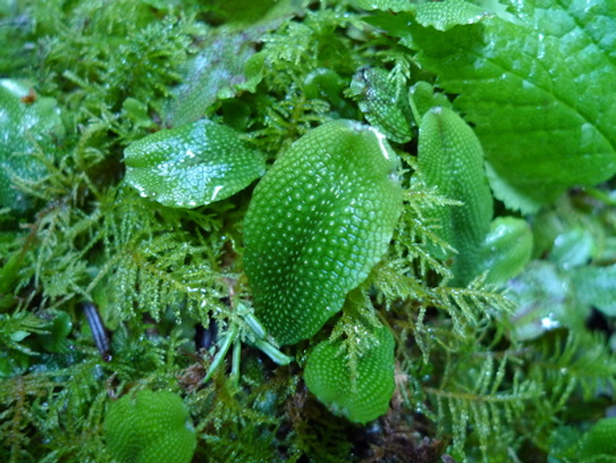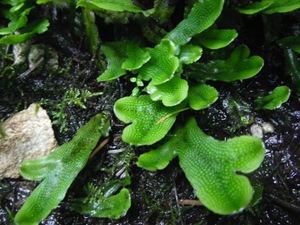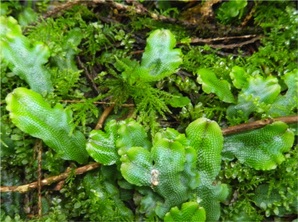Snake liverwort • Conocephalum conicum
{Conocephalum conicum = reference to this species' cone-shaped sporophyte capsules}
Photos of snake liverwort by Jennifer Elliot (top), Katy Fulton (bottom left), and Mary Vasey (bottom right).
Identification
This richly-coloured light green liverwort gets its common name from the scaly hexagonal markings of outlined air chambers on its surface. Each hexagon has a small white-ringed pore in the centre. The thallus (body of the plant) is irregularly branched and flat with branches extending away from the main body. Less branched specimens resemble scaly ribbons. It occasionally produces capsules, which have cone-shaped heads. Snake liverwort releases a strong but pleasant odour when crushed. This and its hexagonal surface texture distinguish it from other liverworts.
Habitat & Range
Snake liverwort grows on wet rocks and moist inorganic soil in damp locations such as behind waterfalls and in moist woodlands. It is common throughout much of Canada. Its global distribution also includes the United Kingdom.
Similar Species
Lung liverwort (Marchantia polymorpha) can appear similar; its thallus surface is textured with outlined air chambers, but these little chambers are not hexagonal in shape.
See the Introduction to Bryophytes species page for more information about this species.
This richly-coloured light green liverwort gets its common name from the scaly hexagonal markings of outlined air chambers on its surface. Each hexagon has a small white-ringed pore in the centre. The thallus (body of the plant) is irregularly branched and flat with branches extending away from the main body. Less branched specimens resemble scaly ribbons. It occasionally produces capsules, which have cone-shaped heads. Snake liverwort releases a strong but pleasant odour when crushed. This and its hexagonal surface texture distinguish it from other liverworts.
Habitat & Range
Snake liverwort grows on wet rocks and moist inorganic soil in damp locations such as behind waterfalls and in moist woodlands. It is common throughout much of Canada. Its global distribution also includes the United Kingdom.
Similar Species
Lung liverwort (Marchantia polymorpha) can appear similar; its thallus surface is textured with outlined air chambers, but these little chambers are not hexagonal in shape.
See the Introduction to Bryophytes species page for more information about this species.
References
Ellis, S. Conocephalum conicum. Introduction to Bryophytes. Biology 321, Department of Biology, University of British Columbia, Vancouver. Accessed 17/12/2014.
Liverworts Conocephalum conicum. Biology 321 Course Website. Biology 321, Department of Biology, University of British Columbia, Vancouver. Accessed 17/12/2014.
Pojar, J. and MacKinnon, A. (2005). Plants of Coastal British Columbia, Revised. Vancouver, BC: Lone Pine Publishing. P. 446.
Authors and editors of page
Paige Whitehead, Kelly Fretwell, and Brian Starzomski (2014).
Ellis, S. Conocephalum conicum. Introduction to Bryophytes. Biology 321, Department of Biology, University of British Columbia, Vancouver. Accessed 17/12/2014.
Liverworts Conocephalum conicum. Biology 321 Course Website. Biology 321, Department of Biology, University of British Columbia, Vancouver. Accessed 17/12/2014.
Pojar, J. and MacKinnon, A. (2005). Plants of Coastal British Columbia, Revised. Vancouver, BC: Lone Pine Publishing. P. 446.
Authors and editors of page
Paige Whitehead, Kelly Fretwell, and Brian Starzomski (2014).






